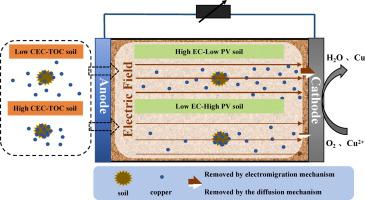Bioelectrochemistry ( IF 4.8 ) Pub Date : 2020-07-08 , DOI: 10.1016/j.bioelechem.2020.107596 Jingran Zhang 1 , Yanqing Liu 1 , Yilun Sun 1 , Hui Wang 2 , Xian Cao 3 , Xianning Li 1

|
Microbial fuel cell (MFC) technology is widely used to remediate heavy metal pollution of soil, and the applicability of soils with different physical and chemical properties under micro-electric field has not been studied. In this study, copper was effectively removed in four typical soil-filled MFCs. The removal efficiencies of copper from closed-circuit MFCs filled with paddy, red, black and alluvial soils were 2.9, 1.50, 3.48 and 3.40 times higher than those in the open-circuit control group, respectively. However, the contributions of electromigration and diffusion mechanisms were different under different soil types. The greatest copper removal (19.3 ± 0.8%) was achieved based on electromigration of the electric field inside the paddy soil MFC in 63 days, while the greatest copper removal (25 ± 2%) was achieved under the action of diffusion mechanism inside the red soil MFC. According to redundancy analysis, the removal of copper by electromigration was positively correlated with electricity generation performance and acid extractable Cu content, whereas copper removal based on diffusion was positively related to soil pore volume and acid extractable Cu content. The cation exchange capacity and total organic carbon of soil were negatively correlated with the acid extractable Cu content, and electrical conductivity of soil was positively correlated with the MFC electricity generation performance. Furthermore, the directional movement of protons under an electric field alleviated the issue of soil acidification caused by citric acid.
中文翻译:

土壤类型对生物电化学系统中重金属去除的影响。
微生物燃料电池(MFC)技术被广泛用于修复土壤中的重金属污染,尚未研究具有不同理化性质的土壤在微电场下的适用性。在这项研究中,铜被有效地去除了四个典型的土壤填充MFC。从充满稻田,红色,黑色和冲积土壤的闭路MFC中去除铜的效率分别比开路对照组高2.9倍,1.50倍,3.48倍和3.40倍。然而,在不同土壤类型下,电迁移和扩散机制的贡献是不同的。根据63天内稻田土壤MFC内部电场的电迁移,可实现最大的铜去除率(19.3±0.8%),而在红土MFC内部扩散机制的作用下,铜去除率最大(25±2%)。根据冗余分析,电迁移去除铜与发电性能和酸可提取铜含量成正相关,而基于扩散的铜去除与土壤孔隙体积和酸可提取铜含量成正相关。土壤的阳离子交换容量和总有机碳与酸可提取的铜含量呈负相关,土壤的电导率与MFC的发电性能呈正相关。此外,质子在电场下的定向运动减轻了柠檬酸引起的土壤酸化问题。电迁移去除铜与发电性能和可提取酸的铜含量呈正相关,而基于扩散的去除铜与土壤孔隙体积和可提取酸的铜含量呈正相关。土壤的阳离子交换容量和总有机碳与酸可提取的铜含量呈负相关,土壤的电导率与MFC的发电性能呈正相关。此外,质子在电场下的定向运动减轻了柠檬酸引起的土壤酸化问题。电迁移去除铜与发电性能和可提取酸的铜含量呈正相关,而基于扩散的去除铜与土壤孔隙体积和可提取酸的铜含量呈正相关。土壤的阳离子交换容量和总有机碳与酸可提取的铜含量呈负相关,土壤的电导率与MFC的发电性能呈正相关。此外,质子在电场下的定向运动减轻了柠檬酸引起的土壤酸化问题。而基于扩散的铜去除与土壤孔隙体积和可酸提取的铜含量呈正相关。土壤的阳离子交换容量和总有机碳与酸可提取的铜含量呈负相关,土壤的电导率与MFC的发电性能呈正相关。此外,质子在电场下的定向运动减轻了柠檬酸引起的土壤酸化问题。而基于扩散的铜去除与土壤孔隙体积和可酸提取的铜含量呈正相关。土壤的阳离子交换容量和总有机碳与酸可提取的铜含量呈负相关,土壤的电导率与MFC的发电性能呈正相关。此外,质子在电场下的定向运动减轻了柠檬酸引起的土壤酸化问题。











































 京公网安备 11010802027423号
京公网安备 11010802027423号